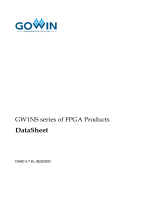Texas Instruments TMS320C6000 DSP Reference guide
- Type
- Reference guide
Texas Instruments TMS320C6000 DSP is a high-performance digital signal processor that is ideal for a wide range of applications, including audio, video, and telecommunications. With its powerful instruction set and豊富な peripheral features, the TMS320C6000 DSP can handle even the most demanding tasks.
Some of the key features of the TMS320C6000 DSP include:
- High-performance 32-bit CPU with a clock speed of up to 300 MHz
- Large on-chip memory, including both program and data memory
- Rich peripheral set, including a variety of timers, serial ports, and DMA channels
- Support for a wide range of software development tools, including Code Composer Studio
Texas Instruments TMS320C6000 DSP is a high-performance digital signal processor that is ideal for a wide range of applications, including audio, video, and telecommunications. With its powerful instruction set and豊富な peripheral features, the TMS320C6000 DSP can handle even the most demanding tasks.
Some of the key features of the TMS320C6000 DSP include:
- High-performance 32-bit CPU with a clock speed of up to 300 MHz
- Large on-chip memory, including both program and data memory
- Rich peripheral set, including a variety of timers, serial ports, and DMA channels
- Support for a wide range of software development tools, including Code Composer Studio



















-
 1
1
-
 2
2
-
 3
3
-
 4
4
-
 5
5
-
 6
6
-
 7
7
-
 8
8
-
 9
9
-
 10
10
-
 11
11
-
 12
12
-
 13
13
-
 14
14
-
 15
15
-
 16
16
-
 17
17
-
 18
18
-
 19
19
-
 20
20
-
 21
21
-
 22
22
Texas Instruments TMS320C6000 DSP Reference guide
- Type
- Reference guide
Texas Instruments TMS320C6000 DSP is a high-performance digital signal processor that is ideal for a wide range of applications, including audio, video, and telecommunications. With its powerful instruction set and豊富な peripheral features, the TMS320C6000 DSP can handle even the most demanding tasks.
Some of the key features of the TMS320C6000 DSP include:
- High-performance 32-bit CPU with a clock speed of up to 300 MHz
- Large on-chip memory, including both program and data memory
- Rich peripheral set, including a variety of timers, serial ports, and DMA channels
- Support for a wide range of software development tools, including Code Composer Studio
Ask a question and I''ll find the answer in the document
Finding information in a document is now easier with AI
Related papers
-
Texas Instruments TMS320C642x DSP Phase-Locked Loop Controller (PLLC) (Rev. B) User manual
-
Motorola TMS320C6711D User manual
-
Texas Instruments TMS320DM643x DMP DSP Subsystem Reference (Rev. E) User manual
-
Texas Instruments TMS320C6712D User manual
-
Texas Instruments TMS320DM646x User manual
-
Texas Instruments TMS320DM355 Digital Media System-on-Chip ARM Subsystem (Rev. A) User guide
-
Texas Instruments TMS320C6727 User manual
-
Texas Instruments TMS320C6000 Chip Support Library API Reference (Rev. J) User guide
-
Texas Instruments TMS320DM355 User manual
-
Texas Instruments TMS320C6454 User manual
Other documents
-
Motorola TMS320C6711D User manual
-
Analog Devices SHARC ADSP-21368 User manual
-
Fujitsu MB15C02 User manual
-
Intel 8XC196Jx User manual
-
Fujitsu MB15F74UL User manual
-
Fujitsu MB15F74UV User manual
-
Altera Stratix IV Device Handbook
-
Atmel 8-bit AVR Microcontroller User manual
-
 GOWIN IPUG769-1.1E Video Frame Buffer IP User guide
GOWIN IPUG769-1.1E Video Frame Buffer IP User guide
-
NXP MC68302 Reference guide























